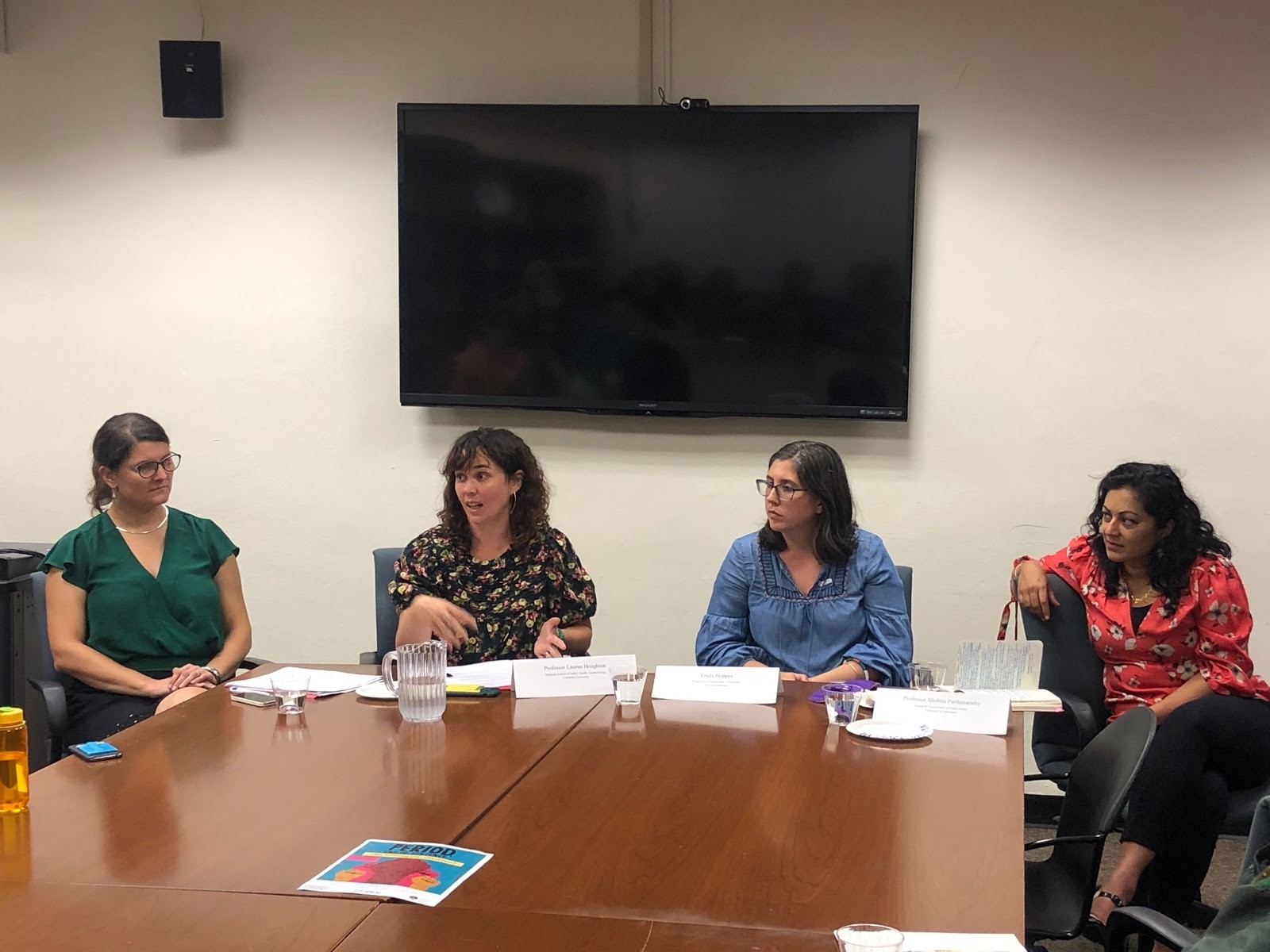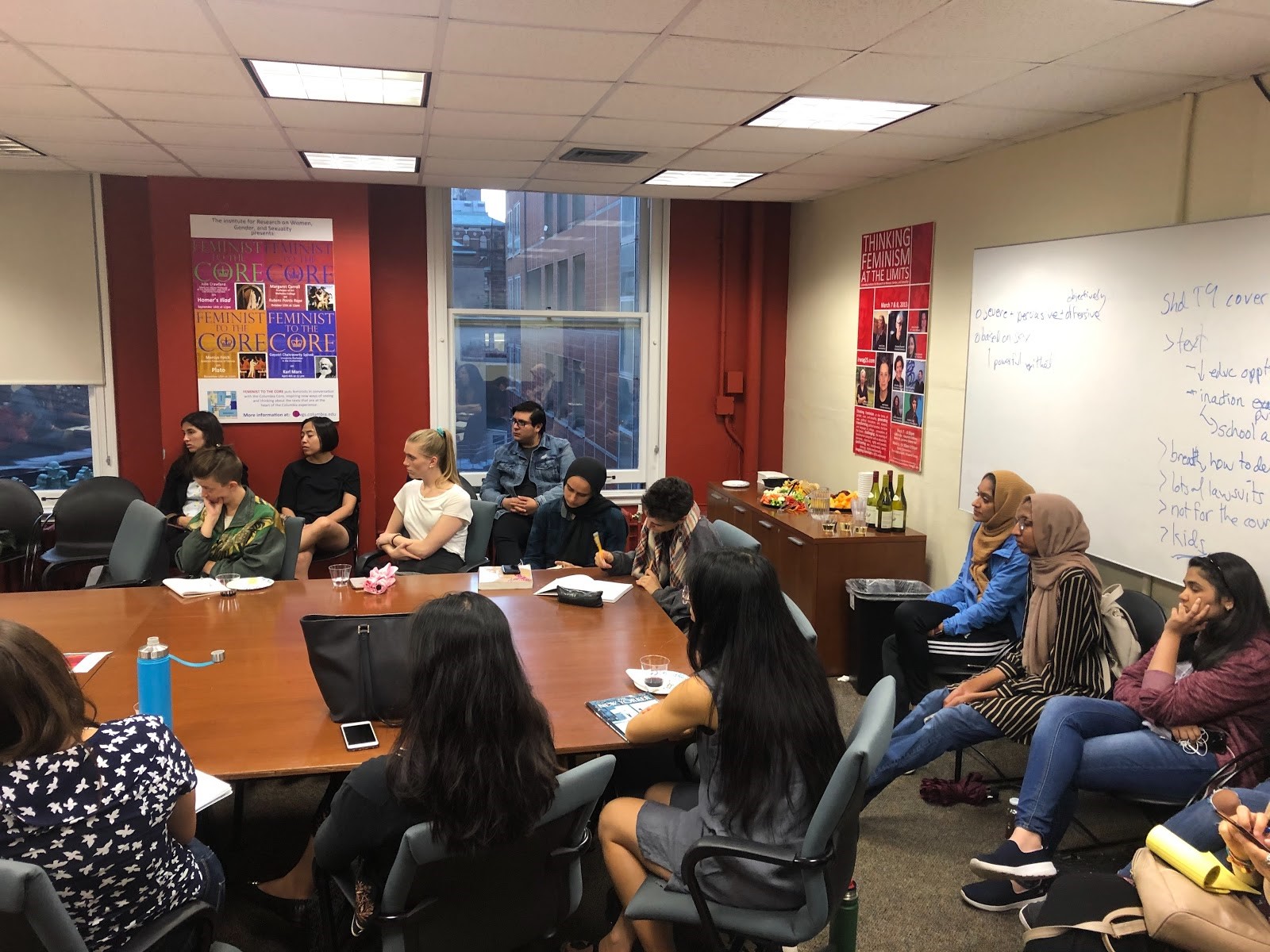By: Laura Charney, RightsViews staff writer
On September 26, the Menstruation and Gender Justice Working Group hosted a film screening and critical panel on the Oscar-winning documentary short Period: End of Sentence. Moderated by Inga Winkler, lecturer at the Institute for the Study of Human Rights at Columbia University and Director of the working group, the panel included Shobita Parthasarathy, Professor of Public Policy and Women’s Studies at the University of Michigan, Lauren Houghton, Assistant Professor of Epidemiology at the Mailman School of Public Health at Columbia University, and Emily Hoppes, a consultant at Huru International.
Period: End of Sentence follows a group of Indian women in the rural Hapur district, 60 kilometers outside of Delhi, as they transition from a life of shame surrounding their periods toward establishing a self-sufficient microeconomy based on menstrual pad manufacturing. During the process, the documentary claims that girls and boys are educated, stigmas are shattered, and a new gender-equitable horizon ascends.
Period: End of Sentence is narrated as a story of empowerment and resilience. Centered on the catchphrase, “a period should end a sentence, not a girl’s education,” the Pad Project – the NGO that funded the film – elaborates on its website: “When a girl gets her period in the United States, she may miss a class. When a girl gets her period in a developing country, she may never go to school again.” While this notion certainly cements grounds for outrage, its accuracy is ambiguous at best.
Menstrual health programming is often obscured by shoddy statistics, lack of thorough quantitative data, and approaches to international development that favor implementing behavioral changes based on generalized survey data. While the panelists agreed that it was exciting to see a film all about periods gain critical acclaim, they critiqued Period: End of Sentence on the basis of its reliance on unreliable research, perpetuation of harmful stereotypes, and iteration of a savior complex rooted in technical fixes.
“Menstrual health management practices have become commodified, scalable, and packageable. The Times of India reports that only 12% of women in India use sanitary pads, while the rest use ‘shocking’ materials like rags. Allegedly, 23% of girls drop out of school when they begin menstruating. These statistics are baseless – we know nothing about how these studies were conducted. Yet they have enormous social power,” Professor Parthasarathy pointed out.
These oft-cited statistics that suggest that girls in developing countries miss schools because of their periods have been widely debunked. The field of international development is rife with “zombie statistics” – statistics, often informed by questionable research, that become ubiquitous.
Even credible quantitative data can compress complex political and economic conditions that produce gender-based inequalities. Often, the impulse to respond to complicated societal imbalances is with market-based solutions. This is particularly manifest in the language of “empowerment,” which posits that women and girls in the global south can manifest their own destiny through offering them skills and labor. Popular solutions in development thinking, such as microfinance loans, locates the solution to impoverished conditions with the individual, rather than with the structural drivers of inequalities, such as national debt or offshoring cheap labor. As a result, the burden of development is often transferred away from the governments and corporations that produce poverty, toward women and girls who become disproportionately responsible for their communities’ livelihoods.
“There are no quick fixes, but the documentary makes it seem that way. The machine provides the fix,” Dr. Winkler said.
Prior to the filmmaker’s team arriving in Hapur, the subjects of the film were generally unfamiliar with single-use pads, and instead, used cloth. The project started when a group of girls from a private high school in North Hollywood learned about a new pad-making machine, raised money through a Kickstarter to buy one, and installed it in a rural village. “The film states that rural India has a menstrual problem, and we have a solution. Yet it does not prove that it is a sustainable solution,” Dr. Houghton noted.
“Indigenous knowledge systems are automatically seen as backwards in ‘developing contexts,’ but there is evidence that the pads are low quality, there are issues with disposal, and the machines break down frequently,” Dr. Parasarathy added.
Introducing western technologies and products as the “solution” reveal both the seductions and limitations of global development thinking. Emily Hoppes, who works for an organization that provides reusable menstrual products and comprehensive sexual and reproductive health education in Kenya, emphasized that products alone are not a sufficient solution to addressing stigma surrounding menstruation, and comprehensive sexuality education is necessary.
Indeed, the pad-making machine, for all its dexterous possibilities, can be understood as an outgrowth of what Dr. Parthasarathy calls “tech saviorism.” Tech saviorism “invites” the receiving subjects of an intervening technology to participate in economic development projects that are facilitated by others, and thus gives off the veneer of self-empowerment. According to this logic, before the introduction of these technologies, women were not already engaged in innovative practices. Instead, their previous practices are understood as embarrassing, dirty, and culturally oppressive. Yet in an era in which sustainable products loom large in menstrual product innovation, one would be remiss to dismiss the potential merits of reusable cloth.
 Inga Winkler, Lauren Houghton, Emily Hoppes, and Shobita Parthasarathy (Left to right)
Inga Winkler, Lauren Houghton, Emily Hoppes, and Shobita Parthasarathy (Left to right)
One scene in the film depicts several women saying that they could not pray in their temple while they were menstruating. Dr. Houghton, who has conducted extensive research in Bangladesh, the UK, and Mongolia on environmental risk factors on women’s health, noted that religion alone rarely dictates gender relations. For some women, observing menstrual practices can be seen as liberatory – a reprise from prayer or cooking for several days.
The fault lines of the global north/south divide are manifest in the approach to menstrual health policies. “In the south, culture is often thought of as a barrier to menstrual health management,” Dr. Houghton said, “whereas in the north, the focus is on biochemical solutions, and culture is ignored. Yet turning the lens on ourselves, what does it say about our culture that we manage our periods with biochemical products?”
One panel attendee, Vanessa Siverls, a menstrual health consultant, pointed out that a major gap in the design of femtech and menstrual innovation is that it leaves behind menstruators who experience unique periods. Irregularities regarding menstruation are not merely a matter of the life course, but also depend on genetic makeups and socioeconomic contexts. Black women are more likely to experience uterine fibroids than women of other races, and more frequently report severe symptoms. Trans and nonbinary menstruators, too, are often left out of policy-based solutions and thus face unique challenges in managing periods in gender-segregated institutions like school bathrooms, shelters, or prisons.
There was one scene in particular that I felt spoke to the counterintuitive nature of the language of empowerment. The film takes us to the interior of a classroom, where we see adolescent girls and boys sitting patiently at their desks. The teacher asks one girl to stand and define “menstruation.” The girl reluctantly rises, hesitates and fumbles through a word or two, then is completely silent. She looks straight ahead, and you can feel her throat choking up with embarrassment as she eventually squeezes her eyes shut. As viewers, we’re called to look on with pity, to patronizingly empathize with the challenges of stigma and shame in a small, rural community; to want to help her empower herself.
I thought back to being a pre-teen girl growing up in Toronto, and how I would have felt if my teacher had asked me to stand in front of my whole grade and to explain what a period was. Because I was a bit of a loudmouth, I probably would have laughed and called on a friend to answer the question. Nonetheless, underneath my performative exterior, I would have been shaking, and mad at my teacher for putting me on the spot.
At the end of the documentary, Mr. Muruganantham, the inventor of the pad machine, says that “the strongest creature is not the lion, not the tiger, but the girl.” Orchestral instrumentation sweeps as the women, once vulnerable and timid, now laugh, hug, and discuss the power of feminism. A slow motion shot captures girls in a schoolyard doing long jump. The spectacle of “girl power” is so overwhelming that I can’t help it when the hairs on the back of my neck slowly stand up: the product takes precedence over the process. In the end, don’t we all want a success story?

